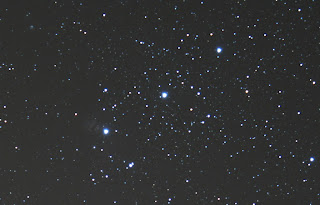
The 3 belt stars in the constellation of Orion are perhaps one of the most recognized asterisms in the Winter sky. Many people are drawn to these 3 beauties almost immediately. Let's take a closer look at these 3 stars.
From left to right, the stars are named Alnitak, Alnilam, and Mintaka, and they are some of the brightest and hottest stars in the sky.
Alnitak is a triple star system, about 800 light years distant, and is sometimes referred to as Zeta Orionis, and the primary star is a class O type blue supergiant. In fact it is the brightest star of it's class visible in our night sky. It is 28 times more massive than our sun, and over 20 times larger. It's companion, Alnitak B is a B type star and orbits the primary once every 1500 years. Alnitak Ab, the third star is also an O type star and was only recently discovered. Nearby this star system is the flame nebula and the horesehead nebula.
Alnilam lies at a distance of 1000 light years and is referred to as Epsilon Orionis. It is a B type blue-white supergiant, and in spite of its farther distance than the other two, is actually the most powerful visible bright star in the sky. This star stands to turn into a red supergiant in about a million years and stands an excellent chance of becoming a supernova.
Mintaka is the right most star in the belt, and is also known as Delta Orionis. It is a multiple star system with a class B giant as the primary and a smaller but hotter class O as a secondary. The stars move very rapidly, orbiting each other about once every 5.7 days. One can only imagine the chaos in this region, some 900 light years distant.
So while we look at this configuration calmly and as a place of great beauty, it is one of the most cataclysmic regions in the heavens, both a stellar nursery and a graveyard, somewhere out on a spiral arm in our own Milky Way galaxy.


No comments:
Post a Comment